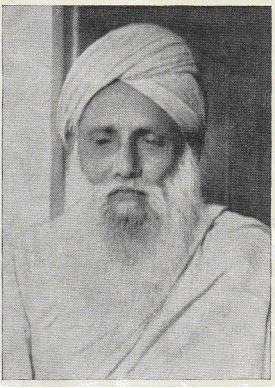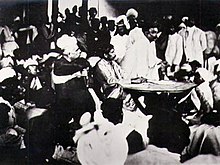
Vande Mātaram is a poem written in Sanskritised Bengali by Bankim Chandra Chatterjee in the 1870s. The first two verses of the poem were adopted as the National Song of India in October 1937 by the Congress.

Bankim Chandra Chattopadhyay was an Indian novelist, poet, essayist and journalist. He was the author of the 1882 Bengali language novel Anandamath, which is one of the landmarks of modern Bengali and Indian literature. He was the composer of Vande Mataram, written in highly Sanskritised Bengali, personifying India as a mother goddess and inspiring activists during the Indian Independence Movement. Chattopadhayay wrote fourteen novels and many serious, serio-comic, satirical, scientific and critical treatises in Bengali. He is known as Sahitya Samrat in Bengali.
Emperor v Aurobindo Ghosh and others, colloquially referred to as the Alipore Bomb Case, the Muraripukur conspiracy, or the Manicktolla bomb conspiracy, was a criminal case held in India in 1908. The case saw the trial of a number of Indian nationalists of the Anushilan Samiti in Calcutta, under charges of "Waging war against the Government" of the British Raj. The trial was held at Alipore Sessions Court, Calcutta, between May 1908 and May 1909. The trial followed in the wake of the attempt on the life of Presidency Magistrate Douglas Kingsford in Muzaffarpur by Bengali nationalists Khudiram Bose and Prafulla Chaki in April 1908, which was recognised by the Bengal police as linked to attacks against the Raj in the preceding years, including attempts to derail the train carrying Lieutenant-Governor Sir Andrew Fraser in December 1907.

Anushilan Samiti was an Indian fitness club, which was actually used as an underground society for anti-British revolutionaries. In the first quarter of the 20th century it supported revolutionary violence as the means for ending British rule in India. The organisation arose from a conglomeration of local youth groups and gyms (akhara) in Bengal in 1902. It had two prominent, somewhat independent, arms in East and West Bengal, Dhaka Anushilan Samiti, and the Jugantar group.
The Revolutionary movement for Indian Independence was part of the Indian independence movement comprising the actions of violent underground revolutionary factions. Groups believing in armed revolution against the ruling British fall into this category, as opposed to the generally peaceful civil disobedience movement spearheaded by Mahatma Gandhi.
Jugantar or Yugantar was one of the two main secret revolutionary trends operating in Bengal for Indian independence. This association, like Anushilan Samiti, started in the guise of a suburban health and fitness club while secretly nurturing revolutionaries. Several Jugantar members were arrested, hanged, or deported for life to the Cellular Jail in Andaman and many of them joined the Communist Consolidation in the Cellular Jail.

Barindra Kumar Ghosh or Barindra Ghosh, or, popularly, Barin Ghosh was an Indian revolutionary and journalist. He was one of the founding members of Jugantar Bengali weekly, a revolutionary outfit in Bengal. Ghosh was a younger brother of Sri Aurobindo.

Shashibhushan Raychaudhuri, also known as Shashida, was a patriotic educationist connected with the radical revolutionary activities that had their origins in Bengal. He was the pioneer in what came to be known as the night-school movement, for building up a self-reliant society.

Bhavabhushan Mitra, or Bhaba Bhusan Mitter, alias Swami Satyananda Puri was a Bengali Indian freedom fighter and an influential social worker.
Pandit Mokshada Charan Samadhyayi (1874–?) was a leading figure of the Jugantar movement.
The first Christmas Day plot was a conspiracy made by the Indian revolutionary movement in 1909: during the year-ending holidays, the Governor of Bengal organised a ball at his residence in the presence of the Viceroy, the Commander-in-Chief and all the high-ranking officers and officials of the Capital (Calcutta). The 10th Jat Regiment was in charge of the security. Followers of Jatindranath Mukherjee, its soldiers decided to blow up the ballroom and take advantage of destroying the colonial Government. In keeping with his predecessor Otto von Klemm, a friend of Lokmanya Tilak, on 6 February 1910, M. Arsenyev, the Russian Consul-General, wrote to St Petersburg that it had been intended to "arouse in the country a general perturbation of minds and, thereby, afford the revolutionaries an opportunity to take the power in their hands." According to R. C. Majumdar, "The police had suspected nothing and it is hard to say what the outcome would have been had the soldiers not been betrayed by one of their comrades who informed the authorities about the impending coup".

The Bande Mataram was an English language weekly newspaper published from Calcutta founded in 1905 by Bipin Chandra Pal and edited by Sri Aurobindo.

Hemchandra Das Kanungo was an Indian nationalist and a member of the Anushilan Samiti. Kanungo travelled to Paris in 1907, where he learnt the technique of assembling picric acid bombs from exiled Russian revolutionaries. Kanungo's knowledge was disseminated throughout Indian nationalist organisations in the Raj and abroad. In 1908, Kanungo was one of the principal co-accused with Aurobindo Ghosh in the Alipore Bomb Case (1908–09). He was sentenced to transportation for life in the Andamans, but was released in 1921.
Jugantar Patrika was a Bengali revolutionary newspaper founded in 1906 in Calcutta by Barindra Kumar Ghosh, Abhinash Bhattacharya and Bhupendranath Dutt. A political weekly, it was founded in March 1906 and served as the propaganda organ for the nascent revolutionary organisation Anushilan Samiti that was taking shape in Bengal at the time. The journal derived its name 'Jugantar' from a political novel of the same name by Bengali author Sivanath Shastri. The journal went on to lend its name to the Western Bengal wing of the Anushilan Samiti, which came to be known as the Jugantar group. The journal expounded and justified revolutionary violence against the British Raj as a political tool for independence, and denounced the right and legitimacy of the British rule in India. It was also critical of the Indian National Congress and its moderate methods which was viewed as aiding the Raj. Its target audience was the young, literate and politically motivated youth of Bengal, and was priced at one paisa.

Pramathanath Mitra, known widely as P. Mitra, was a Bengali Indian barrister and Indian nationalist who was among the earliest founding members of the Indian revolutionary organisation, Anushilan Samiti.
The history of the Anushilan Samiti stretches from its beginning in 1902 to 1930. The Samiti began in the first decade of the 20th century in Calcutta as conglomeration of local youth groups and gyms(Akhra). However, its focus was both physical education and proposed moral development of its members. From its inception it sought to promote what it perceived as Indian values and to focus on Indian sports e.g. Lathi and Sword play. It also encouraged its members to study Indian history as well as those of European liberalism including the French Revolution, Russian Nihilism and Italian unification. Soon after its inception it became a radical organisation that sought to end British Raj in India through revolutionary violence. After World War I, it declined steadily as its members identified closely with leftist ideologies and with the Indian National Congress. It briefly rose to prominence in the late second and third decade, being involved in some notable incidents in Calcutta, Chittagong and in the United Provinces. The samiti dissolved into the Revolutionary Socialist Party in 1930.
The National Council of Education - Bengal was an organisation founded by Satyendranath Tagore and other Indian nationalists in Bengal in 1906 to promote science and technology as part of a swadeshi industrialisation movement. It established the Bengal National College and Bengal Technical Institute which would later merge to form Jadavpur University. Institutions which were functioning under the council were considered to be hotbeds of swadeshi activities and the government banned nationalistic activities such as the singing of patriotic songs.
Surendranath Tagore (1872–1940) was an Indian author, literary scholar, translator and entrepreneur. He is particularly noted for translating a number of works of Rabindranath Tagore to English.

Satyendra Nath Bosu was an Indian nationalist of the Anushilan Samiti. Bosu, while held in Alipore Jail hospital as an under-trial in the Alipore Bomb Case, shot dead the Crown witness Narendranath Goswami with the help of fellow prisoner Kanailal Dutta, leading to the collapse of the case against prime suspect Aurobindo. Bosu gave himself up on the jail premises and was subsequently put on trial. Along with Dutta, he was found guilty and executed by hanging on 21 November 1908 for the murder of Goswami.
Anarchism in Bangladesh has its roots in the ideas of the Bengali Renaissance and began to take influence as part of the revolutionary movement for Indian independence in Bengal. After a series of defeats of the revolutionary movement and the rise of state socialist ideas within the Bengali left-wing, anarchism went into a period of remission. This lasted until the 1990s, when anarchism again began to reemerge after the fracturing of the Communist Party of Bangladesh, which led to the rise of anarcho-syndicalism among the Bangladeshi workers' movement.









